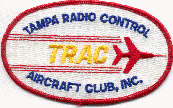A standard four-channel R/C set will suit most airplanes on the market. High performance and precision models will need quality, powerful servos to operate properly.
Let's start by plugging in 4 servos into receiver 1 - aileron, 2 - elevator, 3 - throttle, and 4 - rudder.
Center all trims and strips on transmitter. Install servo grommets and push in screw eyelets from bottom. Now locate servo arm and test fit them to find an arm that will sit square to case.
Mount servos in model on rails or plywood platform. Be certain all mounts are secure and epoxied in place.
Now install control horns on model with pivot holes over center hinge line. Harden area with CA or use plywood doublers.
Locate exit points on back of fuselage, throttle and nose gear. Avoid abrupt bends in rods. Do not use flexible nyrod or single cable as pushrod.
Rudder and elevator control arms need to take off in center of fuselage to make exit point easier to hook up control horns. With a steer able nose gear choose the fuselage side that works with correct rudder direction.
Ailerons are easy. Make straight pushrods; connect; and note with transmitter stick left, left aileron moves up, right stick right aileron moves up.
Throttle set up without travel adjustment end points will take some work.
#1 First, set carburetor arm straight down at 40 or 50% open. With a small rule measure linear motion from closed to open.
#2 At Throttle servo, transmitter stick and trim centered, your servo arm will be square to pushrod now replace arm one ratchet ahead towards engine. Measure linear travel with U-in down from low to high. Find the hole in arm closest to carburetor measurement or slightly shorter.
Hook up linkage from servo to carburetor closed; trim down and stick down. This servo set up brings the throttle trim in faster and slows down at high to avoid binding.
Place switch on side opposing muffler exhaust. A good idea here is to have "push back" as the ON position. The switch plugs into receiver with the single lead out.
Double wrap receiver and battery pack if you have the room. Secure in airframe, remember the battery pack aids in balance; so don't let it get loose.
Exit radio antenna immediately away from receiver - tape to bottom of fuselage, put in tube, or just bind to outside of airplane. Don't cut antenna wire.
Range test radio with antenna down at about 20 or 30 paces.
